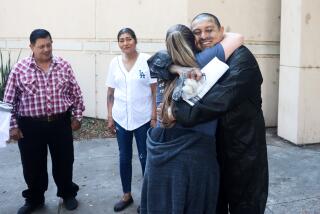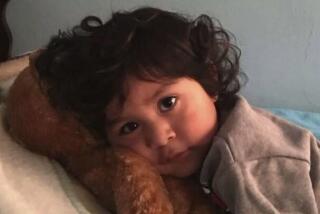Boy’s death seemed like a failure of L.A.’s child-welfare system. It wasn’t so simple
A new report about the death of Noah Cuatro has absolved the Department of Children and Family Services of responsibility in the case.
The case seemed to fit the well-worn narrative about the Department of Children and Family Services.
Noah Cuatro, a Palmdale boy who was well-known to social workers, died under suspicious circumstances while in the care of his parents, who had been questioned in the past about alleged abuse and neglect. The department, weeks before the boy’s death in July, had received permission from a judge to remove him from his home — and didn’t do it.
Yet another child had fallen through the cracks and died. It’s the kind of story that has long haunted Los Angeles County’s troubled child-welfare system.
But now, a new report about the case has found that social workers and their supervisors acted appropriately in leaving the 4-year-old boy at home, despite the tragic outcome.
“They ultimately did the right thing,” said Michael Nash, executive director of the Office of Child Protection, which evaluates child-welfare policy and operations for the county’s Board of Supervisors. “The department had consistent eyes on this family.”
The findings will not spare DCFS from potential lawsuits or from further scrutiny by the Board of Supervisors. And child-welfare advocates interviewed by The Times were more skeptical of the conclusions, raising questions about the report’s overall thoroughness.
“This self-serving, premature report in no way clears DCFS of wrongdoing and was nothing more than a PR stunt to deflect civil liability,” said attorney Brian Claypool, who has filed a $50-million lawsuit against the department in the case of another boy, Anthony Avalos, who died in 2018.
But the report, obtained by The Times through the California Public Records Act, sheds new light on a case that’s been a mystery for weeks, as officials have withheld details to protect the boy’s siblings and the integrity of the ongoing investigation into what authorities describe as a “suspicious death.”
The boy’s parents, Jose and Ursula Cuatro, have not been charged with a crime. Their attorneys didn’t return calls for comment.
The report tightly summarizes confidential case files and begins to answer what had been a central question in the case: Why had social workers filed a 26-page request to remove Noah from his parents’ home and not followed through?
Such decisions happen in only a fraction of the thousands of cases involving removal orders each year, according to the department’s records.
The report explains that despite receiving permission from Superior Court Commissioner Stephen Ipson to remove Noah, social workers decided to leave Noah at home because newer allegations of neglect and abuse hadn’t been substantiated. They did, however, move to “ratchet up” the boy’s supervision, visiting him weeks before his death, said Nash, who also is a retired presiding judge over juvenile courts in Los Angeles.
Nash’s report states that social workers said the boy seemed to be in good spirits and was bonding well with his mother in the months before his death.
Noah died in the hospital on July 6, a day after his parents called 911, saying he had drowned in a pool in an apartment complex. Los Angeles County Sheriff Alex Villanueva later told reporters that the death appeared inconsistent with drowning and launched an investigation. County investigators have said little about their progress and have asked other county agencies, such as the coroner’s office that conducted the autopsy, to do the same.
Meanwhile, questions about the Department of Children and Family Services — still dealing with other cases of children who died under supervision in the Antelope Valley — also have gone largely unanswered.
“When I’m not able to talk about something, there is a part of me that says, ‘I need to get out in front of this,’” said Bobby Cagle, the director of DCFS. “There are bigger things at play, especially when there’s a criminal investigation. I want to make sure I don’t do anything that would inhibit” possible prosecution.
Nash, in his report, however, makes public an official timeline of the interactions between the agency and the Cuatro family, starting in August 2014. That was when Noah was placed in foster care and then with his great-grandmother Eva Hernandez, who also is being represented by Claypool in a potential lawsuit against DCFS.
The report illustrates how the checks and balances of a child-welfare system that’s often criticized for dysfunction, in some ways, operated as intended when it came to the decision about whether to remove Noah. There was a disagreement among social workers about whether it was appropriate to separate the boy from his parents again over new neglect and abuse allegations, and ultimately a supervisor and administrator intervened.
“The real issue is whether DCFS’ investigation of the child abuse reports was an adequate investigation,” said Margaret Coyne, an attorney and executive director of Advokids, which operates a free legal-advice hotline for foster youth.
Child-welfare advocates point out that the report sometimes lists social workers’ decisions without much detail, raising questions about whether DCFS pursued signs of problems aggressively enough. Others have also raised concerns about the completeness of the report, which took more than a month to compile following a directive to do so by the supervisors in the weeks after Noah’s death.
And while the report delves into the thinking behind social workers’ decision not to remove the boy, it doesn’t reveal in detail what they told the court to secure the removal order in the first place or how Ipson responded. Those documents remain secret. An attorney representing The Times, Dan Laidman, argued in court on Sept. 9 that they should be unsealed.
Social workers had been involved with Noah for much of his life. One of their first interactions with him came in 2014, when an infant sibling of Ursula Cuatro suffered a skull fracture while in her care at the family’s home. At the same time, there were allegations that Noah’s father, Jose Cuatro, abused marijuana.
Noah was sent back to live with his parents the following year, after a medical evaluation concluded that the injury to Ursula Cuatro’s sibling wasn’t the result of abuse — and after social workers found no evidence of drug use by Noah’s father.
But by 2016, Noah was returned to foster care after allegations that he had been medically neglected by his parents, who failed to take him to several doctor’s appointments, according to Nash’s report. The court again placed Noah with Hernandez, and his parents began trying to comply with the court’s demands for family reunification.
The parents made “tremendous progress” complying with the case plan, despite some inconsistencies in scheduling overnight visits with Noah, according to the report. And by 2018, a court sent Noah back to his parents over the objections of DCFS officials, who continued to worry about the boy’s connection with his mother.
In the months that followed, social workers had numerous encounters with Noah, who at times seemed normal, according to the report. But he also appeared lethargic during one visit, perhaps from an ear infection, and was ordered to undergo a medical exam after social workers noticed a bruise on his back, which he said was from a fall from a bunk bed.
Still, social workers remained worried, according to the report. At one point, social workers said Noah seemed “coached” and frightened by their presence. Ursula Cuatro, they said in the report, also showed signs of mental illness. She was pregnant but claimed to be serving as a surrogate. She also had failed to enroll Noah in preschool or participate in family therapy.
At least one DCFS worker referred to both parents as “habitual liars who present well,” according to the report.
Then in May 2019, another round of allegations was made through a tip line, with the tipster saying that relatives witnessed Noah suffering from night terrors, and that the boy had seen his father assaulting his mother and that he had possibly been sexually abused.
Based on that information and the family’s history with DCFS, a social worker sought a court order to remove Noah from his home on May 15, even though the tip had not yet been verified by social workers. Ipson approved it quickly, according to Nash’s assessment in the report.
But in the days that followed, Noah’s parents and the relatives whom the tipster had said witnessed the abuse told social workers that the allegations were false. Noah, according to social workers cited in the report, also appeared in good spirits and denied any abuse.
As the DCFS investigation continued, social workers disagreed about whether the order to remove Noah should have been filed.
On May 22, social workers and a senior DCFS official reevaluated the case. Believing that they didn’t have enough evidence of abuse to justify removing the boy from his home, they decided not to use the judge’s authorization to do so. Instead, they agreed to try a formal meeting with the family and Noah, and consider new supervision of Noah’s three siblings, because of their concerns about the mother’s mental health and her noncompliance with court orders, according to the report.
By mid-June, social workers were still investigating the latest allegations. Although they believed the mother neglected Noah, the investigation into alleged abuse by the father was inconclusive. The social workers last saw Noah in late June. He told them he was doing well, according to Nash’s report.
They updated the court in late June and asked for a 30-day continuance to investigate further.
Noah died two weeks later.
More to Read
Sign up for Essential California
The most important California stories and recommendations in your inbox every morning.
You may occasionally receive promotional content from the Los Angeles Times.











